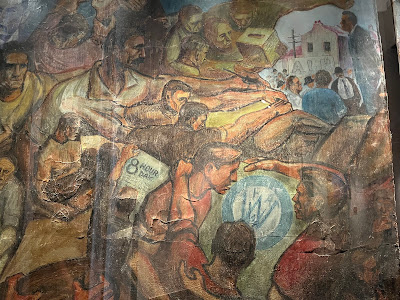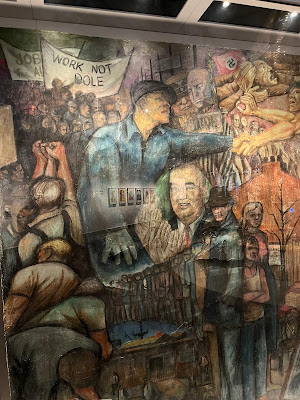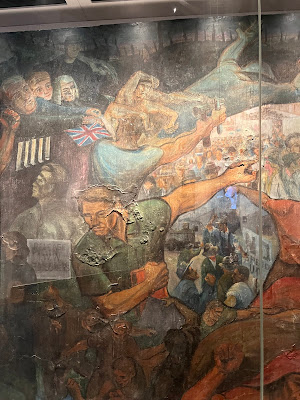One of the most iconic treasures in the Australian National Maritime Museum is the Wharfies’ Mural. It is a window into the cultural movements that occurred among workers on the waterfront during the 20th century, and a reminder of their significant role in broader Australian politics and society.
This mural, an iconic example of Australian working-class cultural expression, originally adorned the canteen walls of the Waterside Workers' Federation building in the busy waterfront of Darling Harbour. Painted in stages mainly between 1953 and 1965, it was a collective effort by nine artists, including waterside labourers, or 'wharfies'.
Though vital to Australia, wharf labouring was hard, dangerous, low-status work. The maritime unions had long fought for improved wages and conditions, and they took a lead role in national campaigns for social justice, minority rights and anti-war activism. This mural celebrates and memorialises that history.
The Waterside Workers' Federation encouraged the cultural and artistic development of its members. With the support of union leader Tom Nelson, artist Rod Shaw and wharfie Sonny Glynn developed a design that could intertwine maritime and labour history. For years wharfies ate their lunch as the artists worked, debating the social and political struggles as they appeared on the wall.
Reflecting the social and political ideals of those involved, the mural for the Waterside Workers' Federation (WWF) canteen was a collective effort. By the 1950s murals were important to left-wing and working-class cultural expression, particularly in communist circles. Rather than elite activities, artistic creation and appreciation were seen as accessible to everyone. Realist art and so-called 'conscious propaganda' were a focus. Producing banners and placards for May Day marches set the creative groundwork for the mural's creation. Mural artist Evelyn Healy for example, first painted banners for May Day in 1938.
Art and politics are often intertwined. The mural examplifies this convergence. Local artists, inspired by Socialist Realism and left-wing thought, formed groups such as the Studio of Realist Art, hoping to take art from a prerogative of a few to a concern of the many. Likewise, progressive film-making, theatre and visual arts in the 1950s sought to depict the seemingly invisible experiences of the working class and make them accessible to all. Created through communal effort and now preserved for future generations, the mural speaks to the wharfies' trials, triumphs and shared cause.
Conversations between the artists, union leaders and wharf labourers guided the struggles and victories that the mural depicted. With the help of wharfie Sonny Glynn, Rod Shaw projected the initial sketches onto the wall and then outlined them in chalk. He then painted over them in oil paint created with pigments from the printery where he worked. Shaw conceived the mural's structure as major themes painted in dark, sepia tones with spaces left for cameos, or small windows, that would be painted in full colour by different artists. He described the effect as 'like a tapestry'.
From those first lines on the wall, the mural eventually wrapped around multiple surfaces in the canteen. It was created in four phases. The first was from 1953 to around 1956 by Rod Shaw with Sonny Glynn, Evelyn Healy, Vi Collings, Harry McDonald and Pat Kelk Graham. The second phase between 1957 and 1960 was painted by Clem Millward and Harry Reade, assisted by Ralph Sawyer. The third phase in the early 1960s saw Sonny Glynn returning to work on the mural with Sawyer. During the final phase after the mural was relocated in several pieces to the new union building, Swayer filled the remaining blank cameo in 1993.
"The ideas for the mural were discussed with a lot of people. Many of us did preliminary sketches for the General Strike of 1917; that's where we started... We got a rough idea and finally Rod put some rough-outs up on the wall." - Artist Vi Collins, 1992
The harsh physical and economic realities of waterside labouring drove the creation of maritime unions in the 1800s - collective effort to ensure safer and more just working conditions. The struggles, aspirations and victories expressed in The Wharfies' Mural reveal a far-reaching trajectory with implications for workers in Australia today. What began as a localised fight on the docks in the 19th century led to ongoing organised agitation for social change. Union support for Aboriginal and Torres Strait Islander justice, women's economic equality, worker's rights, internation solidarity and global peace continues well into the 21st century.
"I believe it is... a very early example of a cooperative work of art. It involved time, a lot of thought, you know, a lot of everything - a lot of heart." - Artist, Clem Millward, 1992







No comments:
Post a Comment